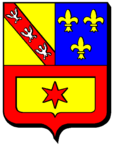Turquestein-Blancrupt
| Turquestein-Blancrupt | ||
|---|---|---|

|
|
|
| region | Grand Est | |
| Department | Moselle | |
| Arrondissement | Sarrebourg-Château-Salins | |
| Canton | Phalsbourg | |
| Community association | Sarrebourg Moselle Sud | |
| Coordinates | 48 ° 34 ' N , 7 ° 6' E | |
| height | 295-826 m | |
| surface | 30.04 km 2 | |
| Residents | 14 (January 1, 2017) | |
| Population density | 0 inhabitants / km 2 | |
| Post Code | 57560 | |
| INSEE code | 57682 | |
| Website | Turquestones | |
Turquestein-Blancrupt (German: Türkstein ) is a French commune with 14 inhabitants (as of January 1, 2017) in the Moselle department in the Grand Est region (until 2015 Lorraine ), about 20 kilometers south of Sarrebourg in the Vosges Mountains.
The community is 30 km² and consists mostly of mountains and forests in the headwaters of the White Saar north of the Donon . It was formed in 1791 and is named after the ruins of the Turquestein Castle , which was built towards the end of the 10th century and destroyed by the French during the Thirty Years' War . There is no central place, the inhabitants live scattered on small farms; a village called Turquestein existed in the Middle Ages, but it was destroyed in 1433. The municipal administration ( Mairie ) is centrally located in the hamlet of Maison Forestière du Bourguignon (forester's house).
Turquestein-Blancrupt is the southernmost municipality in the department of Moselle. The western half of the municipality consists of the Forêt de Turquestein ( Türksteiner Wald ), the eastern half of the Forêt de Saint-Quirin ( Sankt Quirin Forest ), in the middle lies the valley of the White Saar , which is also called Blancrupt ( Kleinweißbach valley ) .
Turquestein has belonged to France since 1661. In the Middle Ages it was still in the German-speaking area, but has been Francophone for centuries . In 1880, out of 130 inhabitants at that time, only three families who belonged to the Mennonite faith were German-speaking .
